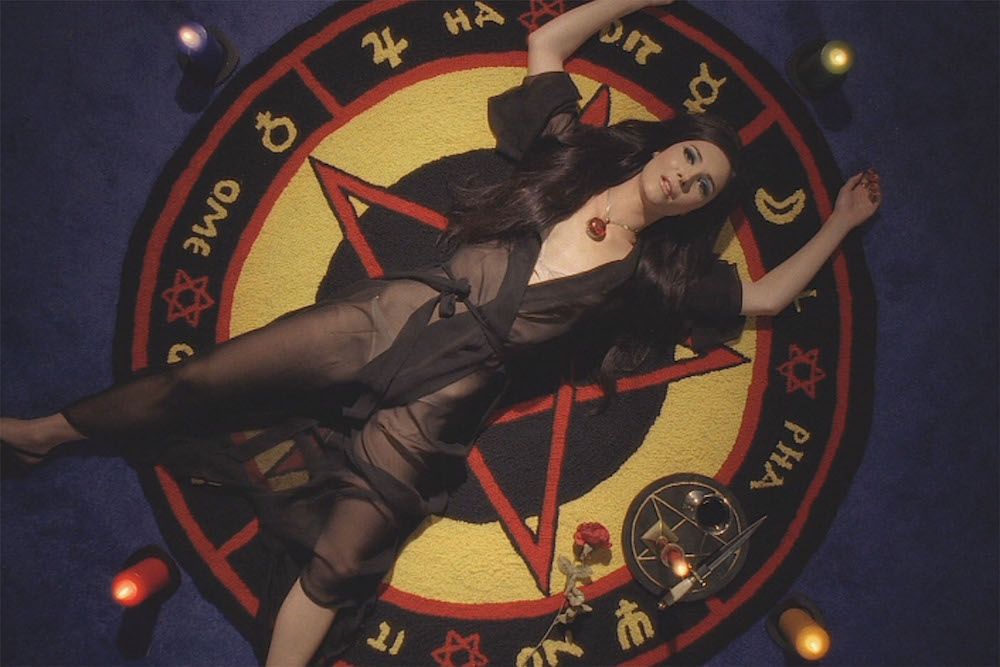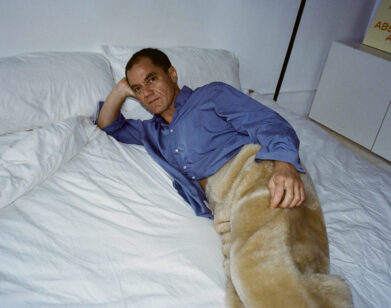Anna Biller’s Practical Magic

SAMANTHA ROBINSON AS ELAINE IN ANNA BILLER’S THE LOVE WITCH. PHOTO COURTESY OF OSCILLOSCOPE.
With witches, sex, death, Satan, love, loss, and many a well-chosen wig, set amongst a hallucinogenic assembly of sets and in luxurious widescreen 35mm, Anna Biller’s heady satire The Love Witch confirms her as an artist art cinema needs most. The Love Witch‘s seduction lies in its anomaly: Biller, a self-professed lover of classic Hollywood and Pre-Code films, is a shrewd critic of the male-authored architecture of femininity and women’s sexuality throughout the history of cinema. With The Love Witch, Biller borrows genre conventions of high saturation-soaked ’60s sexploitation films and rewrites them through her own lens.
Biller devises the arc of a young, glamorous widow and practicing witch named Elaine (Samantha Robinson) with her sights set on finding the “one.” That Elaine, quite literally, is guilty of loving men to death is one of Biller’s strategies for turning a critical lens on patriarchal conceptions of romantic love. Elaine, living in 2016 with her Beyond the Valley of the Dolls eye makeup and teased wig, is a compelling avatar of neediness and narcissism, but has full agency. The writer-director-editor engineered not just the film’s art direction, production design, and costume design, but also composed the music. The Los Angeles-based auteur left no detail forgotten, including a lovingly hand-hooked Pentagram rug.
We spoke with Biller when she was in New York for BAMcinemaFest earlier this year about visual pleasure, the question of glamour, and her upcoming projects. “I’ve always loved movies dealing with the terror of a woman who doesn’t really know her husband and finds out that he’s a monster,” Biller explains of what’s in store. “It’s one of my favorite plots.” Below is a condensed version of our conversation.
COLLEEN KELSEY: Considering The Love Witch and Viva, what about the sexploitation genre attracts you to tell your story as a filmmaker?
ANNA BILLER: What I like about the ’60s movies was that they were about women. They were telling women’s stories. I think a lot of movies don’t tell women’s stories anymore. My real love is the Pre-Code movies in the early ’30s that were all about what happened to women when they would fall [in love with] or get involved with bad men. In the ’60s, they revived that. Sexploitation movies were kind of like the Pre-Code movies in terms of the subject matter. I like the idea of updating the Pre-Code movies as well. It’s not that I’m so into the ’60s and ’70s; what I’m really into is classic Hollywood and Technicolor and a certain kind of art direction, makeup, and lighting. Because I’m dealing with sexual themes—female desire and pleasure—it ends up feeling like the sexploitation movies because those are the colorful movies that are exploring female sexuality.
KELSEY: The witch is such a powerful, historical trope in terms of women’s sexuality that’s been handed down through millennia.
BILLER: Yes, exactly. That’s why I chose a witch as the protagonist.
KELSEY: Could you tell me a little bit about coming up with this particular story?
BILLER: I base everything on my own life experiences as a female. I start from there, and then I look for characters and settings that I think are cinematic, where I can use symbols and imagery to tell a story. I did find that the witch was the perfect iconic figure in which to discuss all of these issues, as you said. What I’m really trying to do is recreate classic Hollywood cinema and classic genre cinema from a woman’s point of view. That’s why I like to use those genres and the conventions of those genres. Because most cinema is really made for men, how can you create cinema that’s for women without having it be relegated to a ghetto of “chick flick” or something like that?
KELSEY: That was one of my next questions, actually, which was about reclaiming a genre that deals with women and sexuality, but has been typically authored by men.
BILLER: Sometimes you don’t really have to change things that much, but the little changes make a huge difference. I really love Hitchcock’s films. They’re so much about voyeurism. I’m also a voyeur. [laughs] I think all directors are voyeurs. So I like to think about, what is my voyeurism about? I think it’s narcissistic. Women sometimes really love to look at other beautiful women on the screen. But they don’t look at a woman the way a man looks at a woman. They want to be that woman. They like if a woman is beautiful or sexy, especially if she’s powerful. They like to see her catch a man, or to be powerful in the world. I think this is why a lot of women love noir films and classic films because they can really identify with these really strong, beautiful women. That’s the kind of power that women have lost culturally. We’ve gained so many more things, but we lost that kind of sexual power, the glamour power. We still love women who can still do that in culture. I think glamour is a female thing. I don’t think that’s a male fantasy. I think glamour’s a female fantasy. That’s one of the reasons I love the Pre-Code films. They showed women who were very bare, so that was the male fantasy part of it. But the rest of it was really gay men and women’s fantasies. I like to highlight that, to bring dignity and power back to female glamour. I think women love glamour. I mean, not all women, but I think this is something that women share. So, Elaine, the main character, I think the men are looking at her body. They want to see her nude. I think the women are looking at her costumes and her hair and makeup; I think that that’s the female gaze.
KELSEY: It’s so fascinating to see the relationship with Trish because their relationship, at the beginning, it starts with fascination about Elaine, and then towards the end, after Elaine’s sunk her claws into Trish’s husband, it turns into this very grotesque insecurity.
BILLER: I think all women have parts of Elaine and Trish in them, and men tend to stereotype women as if they’re one or the other. Like women are just this iconic sex goddess, or women are kind of plain or the wife, buddy person. But women are all of those things, and they shift and they change. Maybe that’s a little bit of the female point of view as well, to show how the character, Trish, who’s just not at all into seducing men, using her appearance, and not at all into manipulating men, and she’s very comfortable with herself, how she can become a character like Elaine through insecurity and through being bullied into it? And you see that Elaine actually went there through grief as well.
I’m trying to talk about the good and the bad of it. I think when a man talks about the good and the bad of a sex siren, he’s not talking about it in the same way. He’s talking about how it’s good and bad for him. [laughs] But this story is about how it’s good and bad for the women themselves. I think that’s what the Pre-Code movies did. That’s why they were so fun for women and so important for women. All those movies like Baby Face [1933] that showed women struggling to live in a man’s world and to survive in any way they could. Sometimes using their sexuality, sometimes not. Just trying everything, but always sort of failing, in a way, because the cards were stacked against them. I see being a woman in the world as a social problem. I think men think that the content is a joke about recreating a ’60s film. That’s not at all what I’m doing. I’m trying to talk about lived, everyday female experience. That’s very urgently problematic in terms of it still being a man’s world, and women’s identities still being shaped by the way men look at them, and the way men can control what kinds of opportunities they can get based on how desirable the men find them, or how compliant. I don’t think that’s really changed a lot.
KELSEY: You control the means of production in terms of directing, producing, determining every little detail from production design to costume design. So, when you’re working on a film—what is your process of gathering all of these ideas together and setting them in motion?
BILLER: First, I start the script. The script was really difficult for me because it’s very ideological, but I didn’t want it to seem didactic. So at first there were many rewrites of the script. Then I started to have to rewrite the script just for practicality, to make it doable, cheaper—cut scenes, combine scenes—try to make it something that could be produced. So I kept rewriting and rewriting it. While I was rewriting it, I was drawing. Drawing the sets, drawing costumes, drawing characters. Watching movies and storyboarding. I do all these little paintings, I research colors. That grows organically over time, where the vision of the character and the world she lives in is flushed out. As I flush that out visually and do drawings, I go back to the script, rewrite the script to include the visual elements. Even when I cast it, then I also have to change it a little bit depending on the characters, the actors I find, the qualities they’re bringing, and things I want to expand according to the cast. After I cast Samantha Robinson, we worked together on the dialogue and we changed some of the dialogue because there were certain things that didn’t feel like her. I had some sketches, but I didn’t really design her wardrobe until I cast her because I wanted to suit her.
KELSEY: How much research did you do regarding magic and occult?
BILLER: I did quite a bit of research. I read a lot of books and I talked to witches and I went to rituals and classes. I started doing a little bit of practice as a witch—as a solitary witch.
KELSEY: I have to ask about the tampon potion scene.
BILLER: Witch bottles, that’s a real thing. In witchcraft, personal objects carry a lot of power. Anything anybody’s used, a comb, a lock of hair, a drop of sweat, anything that comes from somebody’s body has incredible magical power. People have historically made witch bottles using their urine, hair, and also herbs, nails, pins, and things, to scare away the spirits. That’s an ancient practice. That came out of my research.
KELSEY: What percentage of the wardrobe did you make versus sourcing vintage?
BILLER: About 50-50. The most labor-intensive costumes were the Renaissance fair costumes and those were the ones that I made. That was the hardest part. There were so many pieces involved and headdresses, and it was really a lot of work. I try not to make more than I have to. I look online, I go to rental houses and see what’s available. But that period costume, the Italian Renaissance, 15th century, there are no costumes available. There are also no patterns available. But I really wanted to do that period because it feels very lyrical and natural, fairytale life.
KELSEY: I also wanted to talk a little bit about palette and color.
BILLER: For the tearoom scene, I was trying to create a feminine environment on purpose. I’ve been to tearooms where the feeling is intensely feminine with the kinds of china and the way women dress and they wear the hats with flowers and everything. I just thought I would exaggerate that quality of a totally feminine space—making it all pink and exaggerating that. But Elaine’s apartment, I’ve never used that many colors in one set ever in my life. I’m usually kind of strict about keeping it to two or three colors, so that was really a weird set. I wanted her to seem really, really weird, like really wild. That color palette came from the Thoth Tarot deck, as it says in the script. There are some cards, that are the fire cards, which are the sun cards, that are orange, yellow, and red. And there are other cards that are blue and purple. I designed her living room around the orange and yellow cards of the Thoth Tarot and the dining room and the magic room in the moonlight cards of the Thoth Tarot. When you put those colors together, because you can see the depth of the room behind it, then it becomes really wacky.
KELSEY: The film takes place in the present day, and it’s heightened through a mirror fantasy of Elaine’s fantasies. Or at least that’s how it appeared.
BILLER: Yeah, that’s exactly right. So, her fantasies of being a fairy princess or a bride or the fanciest My Fair Lady heroine or something … those are put on screen. Her being some powerful witch with potions, those are put on the screen. I think, again, when men create movies about femme fatales, it really is always about how that female can destroy that male. It’s not really about what’s happening on the interior of that female. Also when [Elaine] is with these men, these men are so disappointing. You don’t see a film noir hero being lame and disappointing. [laughs]
KELSEY: I think we could possibly say that Elaine has impossible standards. But I don’t think that they’re so impossible.
BILLER: All she wants is love, just to be loved for herself. That’s what she tells Griff. That all she’s wanted. He’s very tough on her. They’re all really tough on her, in a way. The other men love her for this image of perfect sexuality and glamour, and Griff doesn’t love her because she’s putting on that mask. He’s refusing to love her because she’s not authentic to herself. But the thing is that, he’s not giving her a break. I think a lot of women who are celebrities and who are very beautiful have terrible problems with their men being very controlling. Women allow themselves to be dominated and controlled by men in all sorts of other ways that are very complicated, you know? I don’t really see a lot of women engaging in discussions about the struggles and power relations with men and their lives, like their bosses, boyfriends, husbands, coworkers. I don’t see that happening very often, whereas I see a lot of misogyny on the internet. I see a lot of hatred towards women and a lot of fear of women. This whole thing about this witch that everybody wants to burn… I feel like that’s how women feel in a way. You can get paranoid because everyone actually is a conspiracy to diminish your power. [laughs] I think the figure of the witch is because, everyone’s afraid of a witch and she’s evil, and she’s this, and she’s that, so it’s a good metaphor.
THE LOVE WITCH IS NOW OUT IN LIMITED RELEASE.






